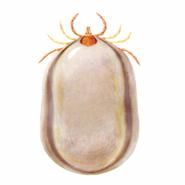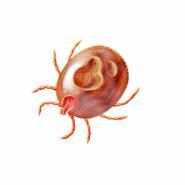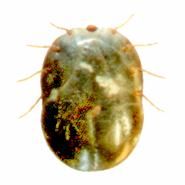DISTINGUISHING COMMON TICKS on the EAST COAST of AUSTRALIA
Commonly found are: the paralysis tick, the cattle tick , the brown dog tick, and the bush tick (note the term "bush tick" has been applied to a number of tick species including the paralysis tick, but in this case refers to the introduced tick Haemaphysalis longicornis). For direct comparison between these see the table below. For a taxonomic key go to the page Identification. Though not nearly as frequent, many other ticks have been recorded on dogs in Australia- see ticks found on dogs .
Table for direct comparison of the common ticks on the East Coast of Australia
To remove the menu for a wider view click here
| Paralysis
Tick Ixodes holocyclus |
Bush Tick Haemaphysalis longicornis |
Cattle Tick Boophilus microplus |
Brown Dog
Tick Rhipicephalus sanguineus |
 fully fed paralysis tick body pear shaped to oval scutum oval, wider at rear |
 half-fed bush tick |
ventral view |
|
|
|
|
|
Paralysis tick (Ixodes holocyclus)Legs first and last pair brown, others pale; in V-shape line from snout down sides of body; body pear shaped to oval; shield oval, wider at rear; snout very long. Ixodes spp have an anal groove which curves around anterior to the anus (cf. the bush tick Haemaphysalis longicornis on this page). This groove can be seen with obique illumination. The un-engorged female is yellowish. The engorged female greyish and usually less than 1 cm in length (but reported up to 1.8 cm). Found coastal QLD, NSW VIC (to Lakes Entrance) and TAS (but the Tasmanian tick probably belngs to another species, see distribution). Also New Guinea , India and Indonesia. [In the male the body is flat, oval, yellow-brown and the shield covers entire dorsal surface. This tick is native to Australia and lives mainly on bandicoots and other small marsupials. However, it also attacks domestic animals and people. It is a serious pest in coastal regions with bush or scrub country. It can kill cattle, mainly calves and small domestic animals. Adults are seen in late winter, spring and summer. Larvae follow in late summer and autumn, nymphs in late autumn and winter. Adults are the only stage generally seen on cattle and then only in very small numbers. It has minimal effects on native animals but causes paralysis in others. Small numbers of adult ticks can be fatal to all young animals. |
Bush tick - (Haemaphysalis longicornis)Legs dark red-brown; first pair close to snout; body oval; shield broadly oval; snout short, wider at face. Haemaphysalis spp have palpi with flared second segments. Like Ixodes spp, these ticks lack eyes, but they differ in having festoons and a posterior anal groove. Found coastal NSW and QLD, common on cattle, horses and dogs. Introduced from northern Japan, it was first recognised in 1901 in northeastern NSW. It is a livestock pest in coastal regions, building to great numbers in favourable seasons. It causes losses in production. Nymphs and adults first seen early in spring. Adults are most numerous in spring and summer. Larvae follow in late summer, nymphs in early autumn. Mainly affects cattle, deer, horses, donkeys and dogs, but also infests sheep, goats, pigs and humans. In cattle, "tick worry" lowers production and tick bites damage hides. In horses there is tick worry and skin irritation. In other animals tick worry also occurs. |
Cattle tick (Boophilus microplus)Legs pale cream; wide space between first pair and snout; body oval to rectangular; shield oval, wider at front; snout short, straight. Found NSW and QLD, mostly on cattle, occasionally on dogs. Introduced at Darwin on cattle from Indonesia in 1872, it spread through Queensland and reached NSW in 1906. The most serious external parasite of cattle in Australia. It spreads tick fever in cattle and causes enormous economic losses in the industry. It is controlled by the Department of Agriculture in NSW, where planned control programs, quarantine areas and regulations for livestock movement keep the number of infested properties low. If you find cattle tick you should notify the District Veterinary Officer. It can be seen at any time of the year but mainly from spring to autumn. Numbers increase throughout summer and autumn but decline sharply in winter. Affects mainly cattle, buffalo and deer but can also infest hoses, donkeys, sheep, goats, dogs and pigs. In cattle, tick fevers weaken and kill, "tick worry" lowers production and tick bites damage hides. In horses there is tick worry and irritation. There is little effect in other animals. |
The brown dog tick- Rhipicephalus sanguineusThe most widely distributed tick species in the world. Also known as the kennel tick in the US. This tick is recorded from practically all countries between the latitudes 50 deg N and 35 deg S (temperate and tropical regions)- ie North, Central and South America, West Indies, Africa, Madagascar, Middle East, East Indies, China, Micronesia, Australia, and southern Europe. In Australia it can be found in many inland areas of Qld, WA, NSW and Vic, but is found found mostly in northern parts of Australia. It is an introduced parasite. The species has a small preferred host range with the dog the main host but may be found on many other mammals, birds and even reptiles that live in association with dogs. Such other hosts may include horses, cattlle, buffalo, camels, cats, deer, goats, sheep, lions, zebra, ostrich, bustard, ibis, hornbill, buzzard, hares, hedgehog, reptiles and humans. This adaptability to such a wide host range is unusual for an ixodid tick. In cooler climates such as the US, eggs of this tick are laid in sheltered areas inside or near housing areas of animals, in cracks and crevices, rather than outside, on the ground under vegetation. Dogs suffer from discomfort, blood loss and infectious diseases. It is a vector for a wide range of infectious agents affecting dogs such as Haemobartonella canis, Hepatozoon canis, Babesia canis, Ehrlichia canis and E. platys. Of these Babesia canis at least, is found in Australia in the northern parts. Infection with Babesia canis may result in a symptomless carrier state or in disease ranging in severity from mild to severe and occasionally ending in death. Ehrlichia canis is a potential exotic disease for northern Australia. In the USA the brown dog tick has also been associated with tick paralysis. For anatomical descriptions see Rhipicephalus sanguineus. For pictures comparing the brown dog tick with the paralysis tick see comparing Rh sanguineus. |
Bibliography
The Board of Tick Control, NSW Agriculture, AG dex 662, 1993- this identification brochure has supplied most of the information on this page.
The Paralysis Tick of Australia - Home
E-mail Us to report a broken link!
